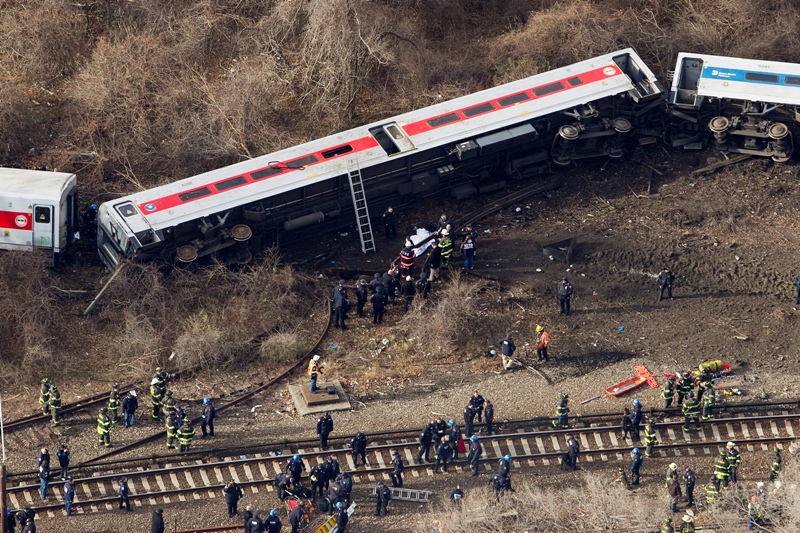Watch the above video: Train derails in New York during U.S. Thanksgiving weekend. Robin Stickley reports.

NEW YORK – A New York City commuter train rounding a riverside curve derailed Sunday, killing four people and injuring more than 60 in a crash that threw some riders from toppling cars and swiftly raised questions about whether excessive speed, mechanical problems or human error could have played a role.
Some of the roughly 150 passengers on the early morning Metro-North train from the town of Poughkeepsie to Manhattan were jolted from sleep around 7:20 a.m. to screams and the frightening sensation of their compartment rolling over on a bend in the New York City borough of the Bronx where the Hudson and Harlem rivers meet.
When the motion stopped, all seven cars and the locomotive had lurched off the rails, and the lead car was only inches from the water. It was the latest accident in a troubled year for the second-biggest U.S. commuter railroad, which had never experienced a passenger death in an accident in its 31-year history.
Joel Zaritsky was dozing as he travelled to a dental convention aboard the train. He woke up to feel his car overturning several times.
“Then I saw the gravel coming at me, and I heard people screaming,” he told The Associated Press, holding his bloody right hand. “There was smoke everywhere and debris. People were thrown to the other side of the train.”
In their efforts to find passengers, rescuers shattered windows, searched nearby woods and waters and used pneumatic jacks and air bags to peer under wreckage. Officials planned to bring in cranes during the night to right the overturned cars on the slight chance anyone might still be underneath, National Transportation Safety Board member Earl Weener said.
The agency was just beginning its probe into what caused the derailment, and Weener said investigators had not yet spoken to the train conductor, who was among the injured.
Investigators were due to examine factors ranging from the track condition to the crew’s performance. New York Gov. Andrew Cuomo said the track did not appear to be faulty, leaving speed as a possible culprit for the crash. The speed limit on the curve is 30 mph (48 kph), compared with 70 mph (113 kph) in the area approaching it, Weener said.
Authorities did not yet know how fast the train was travelling but had found a data recorder, he said.
One passenger, Frank Tatulli, told WABC-TV that the train appeared to be going “a lot faster” than usual as it approached the sharp curve near the Spuyten Duyvil station.
Nearby residents awoke to a building-shaking boom. Angel Gonzalez was in bed in his high-rise apartment overlooking the rail curve when he heard the roar.
“I thought it was a plane that crashed,” he said.
Authorities identified the victims Sunday as Donna L. Smith, 54; James G. Lovell, 58; James M. Ferrari, 59; and Ahn Kisook, 35. Three of the dead were found outside the train, and one was found inside, authorities said. Autopsies were scheduled for Monday, said the New York City medical examiner’s office.
Lovell, an audio technician, was travelling to midtown Manhattan to work on the famed Rockefeller Center Christmas tree, said longtime friend Janet Barton.
Eleven of the injured were believed to be critically wounded and another six seriously hurt, according to the Fire Department. After visiting an area hospital Sunday evening, New York City Mayor Michael Bloomberg told reporters that the 11 who originally were critical no longer appeared to have life-threatening injuries.
Cuomo, in a telephone interview with CNN, said the scene “looked like a toy train set that was mangled by some super-powerful force.”
As deadly as the derailment was, the toll could have been far greater had it happened on a weekday, or had the lead car plunged into the water. The train was about half-full at the time of the crash, rail officials said.
Sunday’s accident came six months after an eastbound train derailed in Bridgeport, Connecticut, and was struck by a westbound train. The crash injured 73 passengers, two engineers and a conductor. In July, a freight train full of garbage derailed on the same Metro-North line near the site of Sunday’s wreckage.
—
Associated Press writers Kiley Armstrong, Colleen Long, Jake Pearson and Jennifer Peltz in New York, Joan Lowy in Washington and Stephen Singer in Hartford, Conn., contributed to this report.


















Comments